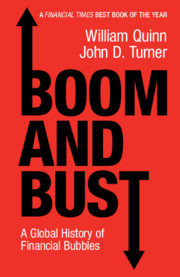Book contents
- Boom and Bust
- Boom and Bust
- Copyright page
- Contents
- Figures
- Tables
- Chapter 1 The Bubble Triangle
- Chapter 2 1720 and the Invention of the Bubble
- Chapter 3 Marketability Revived: The First Emerging Market Bubble
- Chapter 4 Democratising Speculation: The Great Railway Mania
- Chapter 5 Other People’s Money: The Australian Land Boom
- Chapter 6 Wheeler-Dealers: The British Bicycle Mania
- Chapter 7 The Roaring Twenties and the Wall Street Crash
- Chapter 8 Blowing Bubbles for Political Purposes: Japan in the 1980s
- Chapter 9 The Dot-Com Bubble
- Chapter 10 ‘No More Boom and Bust’: The Subprime Bubble
- Chapter 11 Casino Capitalism with Chinese Characteristics
- Chapter 12 Predicting Bubbles
- Acknowledgements
- Notes
- Bibliography
- Index
Chapter 2 - 1720 and the Invention of the Bubble
Published online by Cambridge University Press: 06 August 2020
- Boom and Bust
- Boom and Bust
- Copyright page
- Contents
- Figures
- Tables
- Chapter 1 The Bubble Triangle
- Chapter 2 1720 and the Invention of the Bubble
- Chapter 3 Marketability Revived: The First Emerging Market Bubble
- Chapter 4 Democratising Speculation: The Great Railway Mania
- Chapter 5 Other People’s Money: The Australian Land Boom
- Chapter 6 Wheeler-Dealers: The British Bicycle Mania
- Chapter 7 The Roaring Twenties and the Wall Street Crash
- Chapter 8 Blowing Bubbles for Political Purposes: Japan in the 1980s
- Chapter 9 The Dot-Com Bubble
- Chapter 10 ‘No More Boom and Bust’: The Subprime Bubble
- Chapter 11 Casino Capitalism with Chinese Characteristics
- Chapter 12 Predicting Bubbles
- Acknowledgements
- Notes
- Bibliography
- Index
Summary
Chapter 2 examines the first financial bubble, which occurred in 1720. Following the War of the Spanish Succession, the countries of Europe, particularly France and Britain, were heavily indebted. John Law invented the bubble in order to help the French government reduce their debt burden. He did so by creating a scheme whereby the Mississippi Company would refinance the government debt. Following Law’s lead, the directors of the South Sea Company proposed a similar scheme to refinance Britain’s public debt. Subsequently, the shares prices of the both the Mississippi Company and South Sea Company exploded and then dramatically collapsed. In addition, in Britain there were nearly 200 bubble companies floated on the stock market and the shares of existing companies also experienced a bubble. The chapter briefly discusses similar episodes elsewhere, especially in the Netherlands, but none of these were on the same scale as in Britain or France. The chapter then moves on to discuss the causes of the bubble. The debt conversion schemes turned unmarketable government debt into very marketable company shares. Part-paid shares leveraged the buying of shares in both countries and John Law’s bank meant that France’s entire monetary policy was directed towards creating the bubble. The bubble’s creators were also adept at stimulating speculative investment. The chapter concludes by examining the consequences of the bubble, which were severe and long-lasting in the case of France and minor in the case of Britain.
Keywords
- Type
- Chapter
- Information
- Boom and BustA Global History of Financial Bubbles, pp. 16 - 38Publisher: Cambridge University PressPrint publication year: 2020

